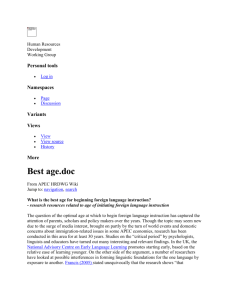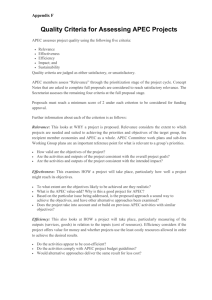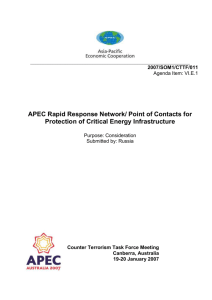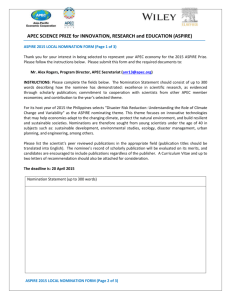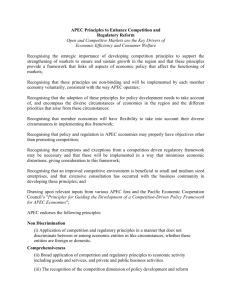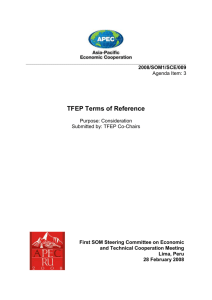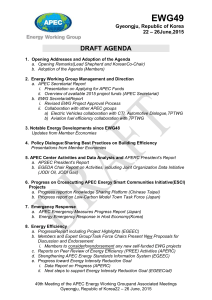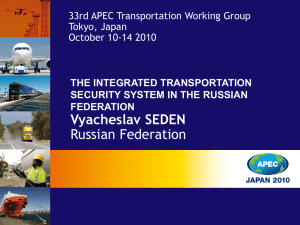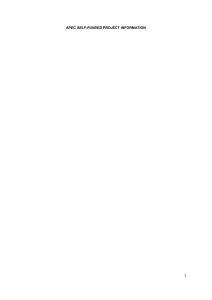Key Themes - Afternoon Session, 14 August 2003
advertisement
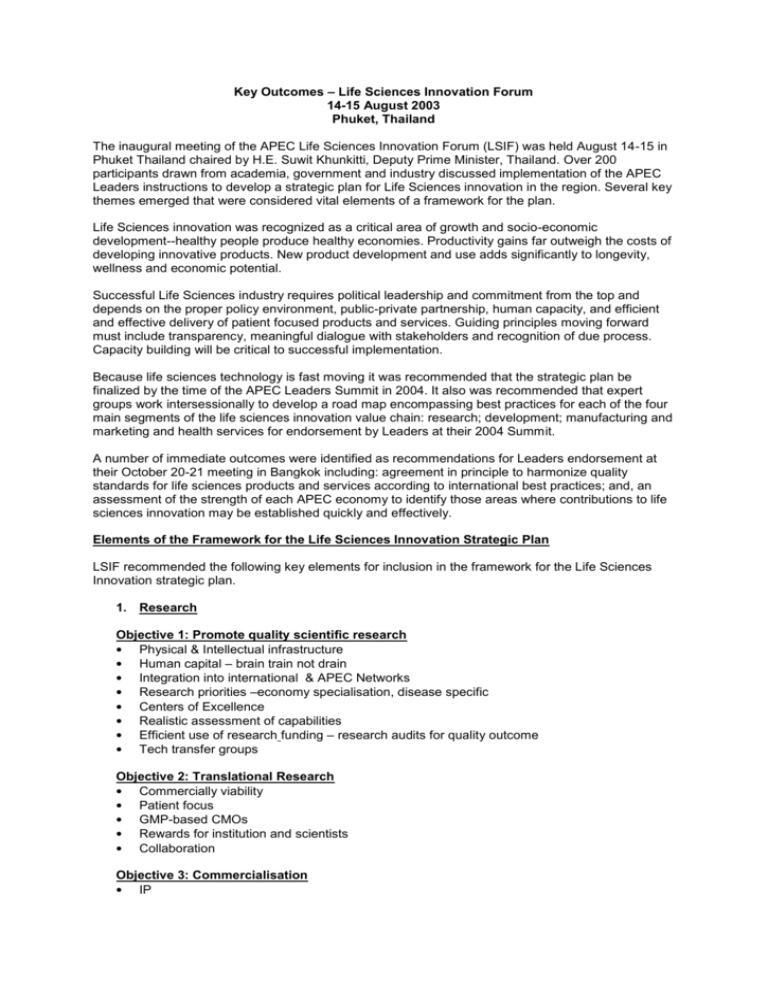
Key Outcomes – Life Sciences Innovation Forum 14-15 August 2003 Phuket, Thailand The inaugural meeting of the APEC Life Sciences Innovation Forum (LSIF) was held August 14-15 in Phuket Thailand chaired by H.E. Suwit Khunkitti, Deputy Prime Minister, Thailand. Over 200 participants drawn from academia, government and industry discussed implementation of the APEC Leaders instructions to develop a strategic plan for Life Sciences innovation in the region. Several key themes emerged that were considered vital elements of a framework for the plan. Life Sciences innovation was recognized as a critical area of growth and socio-economic development--healthy people produce healthy economies. Productivity gains far outweigh the costs of developing innovative products. New product development and use adds significantly to longevity, wellness and economic potential. Successful Life Sciences industry requires political leadership and commitment from the top and depends on the proper policy environment, public-private partnership, human capacity, and efficient and effective delivery of patient focused products and services. Guiding principles moving forward must include transparency, meaningful dialogue with stakeholders and recognition of due process. Capacity building will be critical to successful implementation. Because life sciences technology is fast moving it was recommended that the strategic plan be finalized by the time of the APEC Leaders Summit in 2004. It also was recommended that expert groups work intersessionally to develop a road map encompassing best practices for each of the four main segments of the life sciences innovation value chain: research; development; manufacturing and marketing and health services for endorsement by Leaders at their 2004 Summit. A number of immediate outcomes were identified as recommendations for Leaders endorsement at their October 20-21 meeting in Bangkok including: agreement in principle to harmonize quality standards for life sciences products and services according to international best practices; and, an assessment of the strength of each APEC economy to identify those areas where contributions to life sciences innovation may be established quickly and effectively. Elements of the Framework for the Life Sciences Innovation Strategic Plan LSIF recommended the following key elements for inclusion in the framework for the Life Sciences Innovation strategic plan. 1. Research Objective 1: Promote quality scientific research • Physical & Intellectual infrastructure • Human capital – brain train not drain • Integration into international & APEC Networks • Research priorities –economy specialisation, disease specific • Centers of Excellence • Realistic assessment of capabilities • Efficient use of research funding – research audits for quality outcome • Tech transfer groups Objective 2: Translational Research • Commercially viability • Patient focus • GMP-based CMOs • Rewards for institution and scientists • Collaboration Objective 3: Commercialisation • IP • • • • • • Environment and structure for commercial partnerships (NIH-type structure) Business development unit – Alliances, Spin offs Technology transfer International competitiveness Incubation centers Capital – seed funding Objective 4: Investment in Education & Training • Education structure – life science in primary school curriculum • Awareness/Communication with public and financial institutions • Training Recommendations to APEC Leaders • Make life science a priority and commitment • Increase R&D funding • Efficient and consistent policy environment • Inter-governmental collaborations and networks • Create APEC ‘APMBL’ • Attract private equity institutions and pharmas 2. Development Regulatory Practices Supporting Innovation Transparency Efficiency Flexibility Responsiveness Protects IP Efficient & Robust Clinical Trial Regulation HARMONISATION To expand opportunities for rapid development of innovative medicines Example of ICH as success in Harmonization Harmonization, not “homogenisation” ICH “Mickey Mouse” model Move to globalize ICH activities through ICH GCG Clinical Trials Opportunities in Asia – Large patient base, unique and unmet medical needs, large pool of professionals, IT infrastructure Challenges – Varied social systems, cultures, traditions Different regulations, processes – new & existing Insufficient GCP training Possible players to Unify standards – Charitable research organisations, APEC APEC - Development Different levels of development of regulations in economies across APEC Possible groupings within APEC based on similar standards and needs – e.g. Korea, Chinese Taipei and Japan’s cooperation on ICH E5 Suggested permanent representative of APEC on ICH GCG Development--Harmonized Guidelines or ‘Commonality in Regulatory Guidelines’ Clinical Trials – infrastructure; regulation; patient safety Training, capacity building and education IPR – data exclusivity; IP issues in the regulatory framework Other topics: Examine ICH and the aim/value of partnership Examine policies – regulatory systems 2 Examine and agree core principles of regulation Tripartite Self Assessment Core competencies ‘Needs assessment’ – training, education, infrastructure etc Principles of Operation Activities should be under the umbrella of APEC ‘APEC-wide’ Terms of Reference will be prepared Participation should be open to regulators (government), industry and academia Any activities/agreements will be flexible and should take account of societal or cultural needs Participation in topic discussion should be voluntary Participation and activities will be contingent on resources Any economy can raise new related topics Meetings should leverage other international fora to most efficiently use resources 3. Manufacturing and marketing Broad and lively discussion in three main areas a. Role of regulation in assuring quality products b. Counterfeit drugs and their impact on society c. Trade and investment in life sciences Guiding Principles • Transparency of process – Public notice • Dialogue – Meaningful input into development of regulation – Active collaboration among all groups: regulators, academics, industry • Due Process – Including right of appeal Role of Regulation • Quality standards assure safe and effective medical products throughout the APEC region – For entire supply chain • Quality standards to assure integrity of product use • Not command and control but trust and verification • Uniform adherence to high level of quality Role of Regulation: Actions • Conduct self-assessment to determine current status relative to best practice – WHO 1992 – ICH Q7A – ISO 13485 – National standards • Identify gaps and build capacity as needed • Establish an expert working group to recommend a uniform quality standard Counterfeit Medical Products • Now not only a health risk but an actual impact on health • Now not a cost of doing business but a cause of destruction of business • Long-range goal is to shift from combating counterfeiters to preventing counterfeiting Counterfeit Medical Products: Actions • Conduct self assessment to determine extent of counterfeiting and to understand scope of impact • Build on WHO network of contact points among APEC economies to share information and to deal with crises 3 • • Create public-private sector partnerships within and among APEC economies to combat counterfeiting – Identify most significant resources of counterfeiters – Share best practices, including dealing with internet fraud Establish uniform enforcement, penalty, and risk of being caught Trade and Investment • Sound investment built on legitimate claims of quality, safety, and efficacy – From herbal medicinals to products of recombinant technology • Branded products produced with the certainty of quality under agreed upon standards Trade and Investment: Actions • Conduct self-assessment to identify one or more areas within each APEC economy where contributions to life sciences innovation may be established most quickly and effectively – Consistent, transparent market regulations – Regulatory framework based on sound science and international practice 4. Health Services The Health Services breakout session agreed on the importance of ensuring the recognition and value of life sciences innovation in health care delivery systems, with the ultimate aim of improving health and quality of life of patients in APEC. There was a general agreement that in order to achieve this end, APEC policy makers initiate a process that helps APEC members achieve the following objectives: Develop more inclusive, open and transparent processes for setting health care policies, which solicit and take into account the concerns of the range of stakeholders, including the life sciences industry, patients, and health care providers; Develop a more integrated internal approach to policy making on health care delivery issues, in which relevant government agencies such as health, finance, trade and investment and other agencies work together to develop more coordinated approaches; Develop better means of monitoring performance and quality of health care delivery systems, including for example, accreditation systems. As a first step, the group recommends that APEC members meet in the coming year to develop a menu of best practices in these areas, as well as discussing other possible concrete means of cooperation. 4
